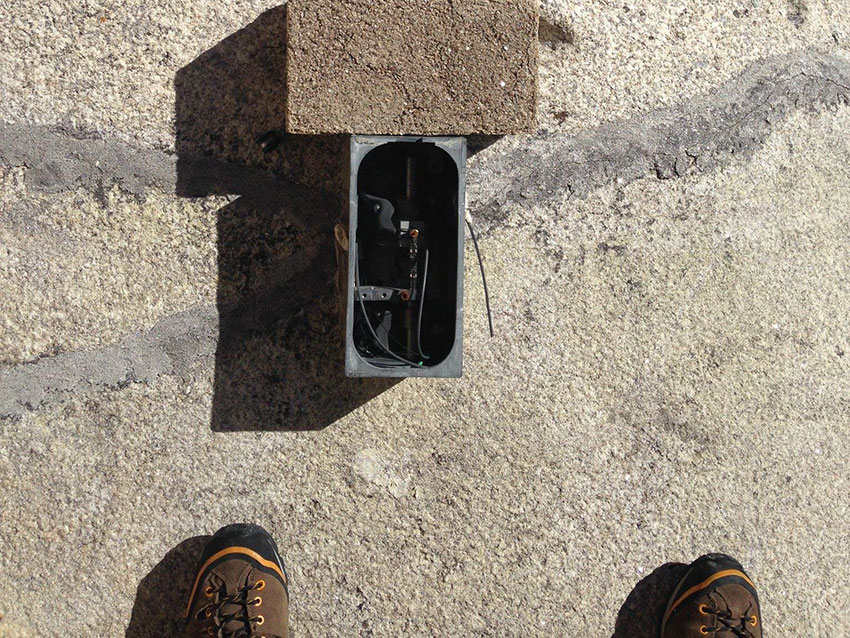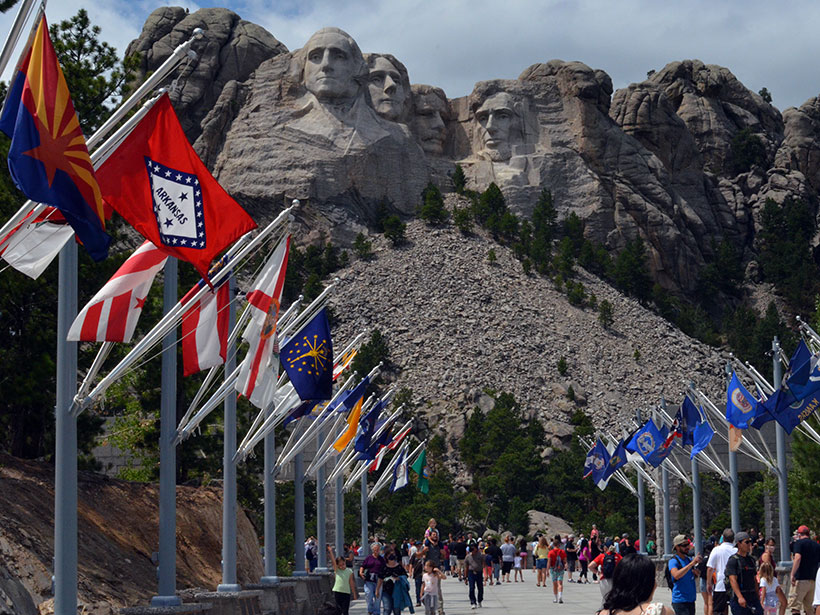Long before four of the largest faces on Earth were dynamited into the granite edifice of Mount Rushmore, the Lakota Sioux saw a different set of portraits: The mountain was known as Tȟuŋkášila Šákpe (the Six Grandfathers).

The site was officially renamed after wealthy New York investor Charles Rushmore only in 1930, years after its famous construction project began, but Tȟuŋkášila Šákpe had been an integral part of Lakota identity for generations. The six entities honored at Tȟuŋkášila Šákpe are the supernatural deities responsible for Lakota creation: North, South, East, West, Above (sky), and Below (Earth).
Tȟuŋkášila Šákpe remains an important spiritual site for the Lakota, and a few outspoken tribal members have called for the carving to be removed. Others say that nature should be allowed to take its course. That could take a while: Granite erodes at a rate of about 2.5 centimeters every 10,000 years, so the 60-meter-high portraits will preside over Pahá Sápa (the Black Hills) of South Dakota for a very long time to come.
Carving a Nearly 2-Billion-Year-Old Bull’s-Eye
From the air, Pahá Sápa appears to be a bull’s-eye ringed by rivers to the north and south and grasslands to the east and west. These features surround the Black Hills’ raised center of rugged granite domes, crags, and spires.
The Black Hills featuring Mount Rushmore National Memorial and @DevilsTowerNM. #FindYourPark #NPS100https://t.co/xu41uvN144
— Jeff Williams (@Astro_Jeff) August 22, 2016
This granite began forming around 1.8 billion years ago, when a molten batholith intruded into existing layers of metamorphic rock. The granite formations remained deep underground for millions of years until the Rocky Mountains began uplifting 65 million years ago. In fact, “the Black Hills are the easternmost extent of the Rocky Mountain uplift,” said Mark Fahrenbach, an environmental scientist with the South Dakota Geological Survey.
After erosion removed about 2,600 meters of overlying rock and sediment, the granite mountains were exposed at the surface about 50 million years ago.
At one time, the mountains of Pahá Sápa may have soared to heights of more than 4,500 meters. Even today, the “hills” moniker shortchanges the dramatic landscape: 2,207-meter Hiŋháŋ Káǧa is the highest peak east of the Rockies, towering nearly 1,000 meters above the surrounding plains.
Granite erodes at a rate of about 2.5 centimeters every 10,000 years, so the 60-meter-high faces will preside over Pahá Sápa (the Black Hills) of South Dakota for a very long time to come.
Hiŋháŋ Káǧa, or Black Elk Peak, was named after Lakota spiritual leader Heȟáka Sápa, more familiar as Nicholas Black Elk, who is himself a part of the Tȟuŋkášila Šákpe identity. Black Elk’s spiritual journey was in part guided by the Six Grandfathers, and his son, Benjamin Black Elk, was a fixture for tourists at Tȟuŋkášila Šákpe in the 1950s and 1960s as the “Fifth Face of Mount Rushmore.” In the 2000s, former Mount Rushmore National Memorial superintendent Gerard Baker introduced park tours in “the Lakota language of Black Elk” and recommended his biography, Black Elk Speaks, to park employees.
The site’s colossal carving was conceived as a scheme to bring more tourism to South Dakota. “Tourists soon get fed up on scenery unless it has something of special interest connected with it to make it impressive,” said Doane Robinson, the South Dakota historian sometimes nicknamed the “Father of Mount Rushmore.” Robinson originally suggested the sculpture include figures relevant to the Dakotas, such as Shoshone explorer Sacagawea and Lakota leaders Red Cloud and Crazy Horse.
Gutzon Borglum, the sculptor chosen for the project, and his team rejected Robinson’s original suggestions. Borglum’s appointment was itself controversial for the site. He was the sculptor of the “Shrine to the Confederacy” in Stone Mountain, Ga.; had already aligned himself with the politics of the Ku Klux Klan; and once said, “I would not trust an Indian, off-hand, 9 out of 10, where I would not trust a white man 1 out of 10.”
Instead of representing Western figures, Borglum and a congressional committee chose to depict four of America’s most prominent presidents: George Washington, Thomas Jefferson, Theodore Roosevelt, and Abraham Lincoln.
Local Indigenous communities immediately objected to the desecration of their sacred lands, which had been promised to the Lakota “in perpetuity” in the Fort Laramie Treaty of 1868. This contract (sometimes called the Sioux Treaty) was widely ignored after gold was discovered in the Black Hills in 1874 and echoes through the decades: When protesters associated with the American Indian Movement briefly ascended the sculpture and occupied Mount Rushmore in 1971, they responded to law enforcement with “We won’t come down unless you honor the 1868 Fort Laramie Treaty.”
In addition to the project itself, Indigenous peoples objected to the anti-Indigenous racist policies of each of the presidents depicted. All four supported forced assimilation, and some supported violence against Indigenous peoples who resisted; Lincoln, for instance, approved the largest mass execution in U.S. history, when 38 Dakota were hanged following the “Great Sioux Uprising” of 1862.
When Borglum set out to select a massive granite canvas, he and Robinson initially identified Hiŋháŋ Káǧa, a cluster of 150-meter-high spires called the Needles in Custer State Park. But “the Needles were too small and unstable for Borglum’s large carving,” Fahrenbach said. “Mount Rushmore has a large exposed area that faces south and receives light all day and is a prominent feature visible for many miles.”

Starting in 1927, Borglum, his son Lincoln, and 400 workers blasted the sculpture into the mountain, removing 450,000 tons of rock, which can still be seen piled in a debris apron below the carving. The workers used dynamite and pneumatic hammers to excavate big chunks of granite and used a technique called honeycombing to remove smaller pieces with drills and chisels. Originally, Borglum intended to carve the presidents’ heads and torsos, but the faces alone took longer than expected and went far over budget.
Harney Peak Granite, the rock underlying the southern Black Hills, isn’t the easiest canvas for carving, as Borglum discovered. “Gutzon would have liked a very fine, homogeneous granite, but Mount Rushmore has areas of large, unstable mineral crystals. The fine granite is also cut by dikes and sills of coarser granite, which caused him to change the position of the faces due to carving properties and aesthetic appearance,” Fahrenbach said. “The granite is also fractured, which caused him to change his design and the placement of the faces several times. What is carved today is actually a smaller version of what he initially envisioned due to areas of weak schist, uneven mineral crystal size, and fracturing.”
The monument was completed in 1941, and today, “nothing stands as a greater reminder to the Great Sioux Nation of a country that cannot keep a promise or treaty then the faces carved into our sacred land on what the United States calls Mount Rushmore,” said Harold Frazier, chairman of the Cheyenne River Sioux Tribe, in a statement earlier this summer.
Keeping Tabs on Massive Blockheads
Since its completion, the effects of erosion on the sculpture have been “negligible,” Fahrenbach said. Regardless, the National Park Service uses the latest rock monitoring technology to keep a close watch on the mountain.
Since 1989, a series of studies has sought to map all the sculpture’s cracks and imperfections in three dimensions. “We then combined those cracks into rock blocks and found 22 individual rock blocks within the sculpture,” said Blaine Kortemeyer, who heads the preservation team at Mount Rushmore. The team, working with RESPEC Engineering, identified four problematic blocks in the faces of Washington, Roosevelt, and Lincoln, two of which “could potentially slide out of the sculpture if they did decide to move.”
In 2008, a rock block monitoring system was installed, consisting of a dozen fiber-optic strain gauges that straddle cracks and track even the tiniest movements of the blocks. “So if and when the rock blocks move, we can see that movement on our computers,” Kortemeyer said. Each year, the blocks expand and contract with the heat and cold of the summer and winter seasons. “It’s the same predictable pattern every year,” he continued, with the widest spread being about the width of a dime.

If the blocks ever do move beyond their seasonal cycles, the preservation team is developing a strategy to secure the carving from the back. “Nothing would be visible on the surface,” Kortemeyer said. “We would shoot a three-dimensional azimuth into the rock, drill in, and pin it from the back.”
In the meantime, Kortemeyer’s crew rappels down the presidents’ faces “whenever necessary” to seal horizontal cracks with caulking. Horizontal cracks can trap water and speed up erosional processes, whereas vertical cracks tend to harmlessly shed water down the face of the mountain. Other than the caulking, there is no coating on the face of the carving, he said. “It’s just exposed granite.”
Geology, in Perpetuity?
In June, Oglala Sioux President Julian Bear Runner called for the carving on Mount Rushmore to be removed, calling it “a great sign of disrespect.”
Former Mount Rushmore superintendent Baker, himself Hidatsa-Mandan, supports the national park: “We’re promoting all cultures of America. That’s what this place is. This is Mount Rushmore! It’s America! Everybody’s something different here; we’re all different. And just maybe that gets us talking again as human beings, as Americans.”
“As a people, we don’t want to see any more desecration on our sacred lands. Blowing up the faces or trying to uncarve it somehow would only cause more damage to the mountain.”
Other Indigenous leaders object to the sculpture but want the mountain left alone to erode naturally. “As a people, we don’t want to see any more desecration on our sacred lands,” said Madonna Thunder Hawk, Cheyenne River organizer for the Lakota People’s Law Project. “Blowing up the faces or trying to uncarve it somehow would only cause more damage to the mountain.”
Granite is an exceptionally durable rock that sheds mere centimeters from its surface over tens of thousands of years. Water seeping into cracks could speed the process, Kortemeyer said, potentially loosening some of the blocks that make up the carved faces.
“If human beings were to disappear tomorrow and nobody was taking care of the sculpture, the cracks that we keep sealed with caulking would start to decay and allow water to penetrate into the natural flaws in the rock,” he said. “That could eventually lead to the downfall of the sculpture.”
Phyllis Young, Standing Rock organizer for the Lakota People’s Law Project, is willing to wait. “The Black Hills have always been a place for healing. We respect that the Earth heals itself. On its own timeline, the mountain will heal itself.”
—Mary Caperton Morton (@theblondecoyote), Science Writer
Living in Geologic Time is a series of personal accounts that highlight the past, present, and future of famous landmarks on geologic timescales.
Citation:
Morton, M. C. (2020), Mount Rushmore’s six grandfathers and four presidents, Eos, 101, https://doi.org/10.1029/2020EO148456. Published on 03 September 2020.
Text © 2020. The authors. CC BY-NC-ND 3.0
Except where otherwise noted, images are subject to copyright. Any reuse without express permission from the copyright owner is prohibited.

